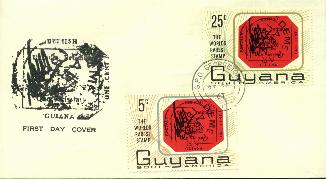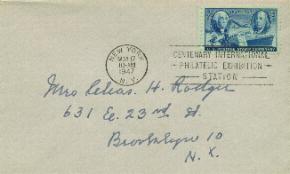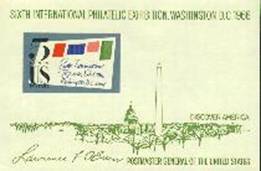|
Practically all collectors, regardless of
their collecting interest reach a point where the cost of living must take precedence
over the pleasures of collecting. Completion becomes either impossible or too
expensive, but the lure of collecting is still there. There is a
solution...topical collecting. But, what topic? To me, the logical one is
stamps on stamps. It offers the attractions of the stamps themselves, while
still allowing the pursuit of knowledge to the extent of one's own personal
desires. There is almost unlimited material available and completion is
whatever goal you set.
But first, a definition of stamps on stamps is in order. The Stamps on
Stamps-Centenary Unit of the American Topical Association (SOSCU), suggests
(note: this is only a suggestion-no formal rules here) three basic types, all
of which can be found on United States stamps. Three types (A, B, and U) are
generally recognized.
Type A: reproduction of the original stamp on the new stamp. See Fig. 1,
showing the famous British Guiana Penny Magenta of 1856, here reproduced on a
first day cover of set of two stamps issued by Guyana in 1967 to honor the
unique stamp.

Figure 1.
Example of a Type A stamp on stamp.
Type B: use of the original design with modifications, such as using a part
of the original design or changing denominations and country names to current
ones. An example of the Type B stamp is shown on the 1947 cover illustrated
in Figure 2, a first day cover to Brooklyn franked with the U. S. three cent
issue of 1947 and cancelled at the Centenary International Philatelic
Exhibition Station. The portraits on the stamp on the cover in Figure 2 are
from the first two U. S. stamps of 1847 and are used as vignettes on the 1947
U. S. Stamp Centenary Issue.

Figure
2. Example of a Type B stamp on stamp.
Type U:
reproduction of a stamp in an unidentifiable form, such as indicating a stamp
on an envelope or in an album, or having a simulated perforation design to
indicate a stamp. Figure 3 is an example of a Type U stamp on stamp as shown
on the 1966 imperforate souvenir sheet issued by the U.S. for the Sixth
International Philatelic Exhibition, Washington, D.C. The five cent stamp on
the souvenir sheet clearly features an envelope franked with four stamps;
however, the individual stamps cannot be identified.

Figure
3. Type U stamp on stamp.
Once you
have decided to collect stamps on stamps, how do you go about it? First,
decide what type you are going to collect, or if like I, you are a general
collector at heart, you'll collect all three. Next, you have to know what
exists, and in this regard there is only one good source. The quarterly
bulletin of SOSCU will alert you to new issues. SOSCU has also published a
handbook (with annual supplements). Of course, if you have unlimited time and
good eyesight, you can always work your way through Scott's catalog. I don't
recommend this. I tried it for several years before I discovered the SOSCU.
Going through the catalog took a lot of the pleasure out of forming the early
collection.
Let's say that you have decided to concentrate on the Type A stamps on stamps,
the reproduction of the original stamps. Again, you have many choices. You
can collect mint, or used, on FDCs or on commercial covers or anyway that
strikes your fancy. That's the great advantage of this type of collecting,
for unless you want to exhibit, and more about that later, you do it the way
YOU want to do it.
In addition to selecting the condition in which you want to collect the
stamps, you may want to have a topic within the topic, e.g. Sir Rowland Hill
Death Centenary. Or stamps on stamps issued for stamp exhibitions.
Suppose Type A looks too simple to you; lets take a look at Type B, where the
original design has been modified. Collecting Type B stamps on stamps can be
a lot of fun, noting all the modifications, some of which are quite subtle.
Unfortunately, most of us cannot afford the original stamps. I had thought it
would be interesting to show the original stamp along with the modified one,
but when the catalog values of the first few I looked up were in the
thousands of dollars, I quickly abandoned that idea. I had no trouble finding
old Scott catalogs, from which I cut out the illustrations of the original
stamps. These illustrations I had enlarged by about two times to give good
size cut-outs to use on the album pages along with the modified stamp.
If it's just pure fun that you are looking for, try collecting Type U stamps
on stamps. These might better be called UFO's. The range of designs is
practically limitless.
Does this all seem too simplistic? After all, you want to do more than
collect pretty pictures, which unfortunately is the view held by many
classical collectors when they think of topical collecting. Never fear, there
is much more.
When I first started collecting stamps on stamps, I was only interested in
the picture, but this soon became rather dull. I wanted to know more, so
started to pay more attention to all the information that was floating around
me in the philatelic press and the catalogs. I wanted to know why the stamp
was issued, who designed, engraved and printed it, how many were issued, and
much more information.
Unless you
have access to an unlimited library of all subjects, determining all of these
elements can be difficult, but there is a lot of good source material. Fields
All-World Miniature Sheet Catalogue and Zinsmeisters Centenary Issues and
Souvenir Sheets of the World are excellent for this purpose. The current
philatelic press will keep you informed of new and forthcoming issues, as
will SOSCU's quarterly bulletin, the SOS SIGNAL. Scott gives the date of
issue, reason for the issue and printing information. Now you have the basic
information about the stamp. You may notice that nothing has been said about
watermark and perforation varieties. These are not usually considered by
topical collectors since the design is the primary area of interest.
Do you have the urge to exhibit? Now you have to observe a few rules if you
want to earn any sort of award. For years, I went to stamp shows and looked
at the topical exhibits of animals, history, birds, etc. All of these
exhibits seemed to tell a story or develop a theme. But, I never saw a stamp
on stamp exhibit, and I couldn't figure out how to tell a story. Then one
year I was lucky to meet a well-known topical philatelic judge and told him
my plight. His reply was simple . . . you can't tell a story with this topic,
but you can concentrate on an aspect of it. I went home and pondered that.
When my local stamp club decided to put on a show, I took the plunge. As I
remember, my first exhibit was Type A mint stamps and FDCs of the world. Very
pretty, but it didn't tell a thing except that lots of countries issued
stamps on stamps!
Then I tried an exhibit illustrating the 3 types of stamps on stamps . .
.still very jumbled. Then I tried British Commonwealth. That was much better,
giving a small tie-in between the stamps shown. The next year did it, for
along came the Sir Rowland Hill death Centenary, which generated lots of Type
A stamps on stamps, with a common reason for being issued and the story of Sir
Rowland Hill to start it off for the title page. This exhibit concentrated on
the stamps of the British Commonwealth and won an award.
My last exhibit, which also won an award, was stamps on stamps issued for
stamp exhibitions. This one was a lot of fun to put together, for in studying
the reasons why certain stamps were selected to be reproduced, some
interesting things came to light. One of the Lubeck stamps reproduced for
INTERPOSTA 1959 in Germany shows the original stamp with a denomination of 2 schillings,
but the inscription on the stamp is ZWEI EIN HALB, which is 2 and 1/2
schillings.
In the past, topical exhibits had to have the stamps of more than one
country, but that has been changed. So, if you have a favorite country where
the needed stamps are beyond your means, why not try a stamp on stamp
collection of that country. Some countries which have issued a fair amount of
such stamps are: Argentina --over 36; Belgium--over 50; Czechoslovakia--over
40; France--over 40 and Spain--over 60. Also, keep in mind that judges frown
on non-Scott listed stamps.
How do you want to collect this topic? You can collect just the stamp itself,
or any ramification of it. I like the mint stamp, which gives a clear look at
the details, coupled with an FDC to show the date of issue. There are also
many special show cancels plus commercial covers showing real use of the
stamp. As noted before, there are no rules of completion. You pick your area
and set your own goals.
I hope this has sparked your interest in stamps on stamps.
|


